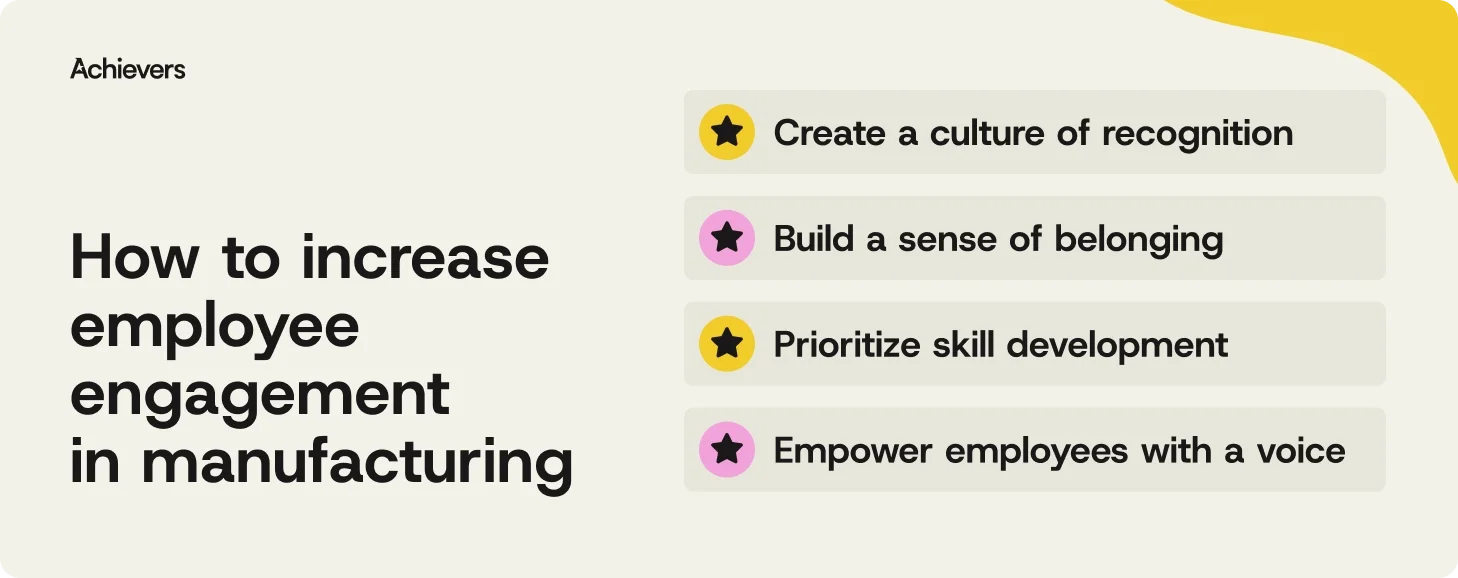Table of contents
Create a culture that means business™
Schedule a demo with an Achievers solution expert today.
When the work is this demanding, employee engagement in manufacturing has to go deeper.
You can’t fake engagement on a factory floor. When people are lifting, fixing, inspecting, and shipping — day in, day out — it shows when they’ve mentally checked out. And manufacturers are feeling the impact. Nearly 60% in NAM’s 2024 outlook survey say attracting and retaining talent is their number one challenge.
Disengagement might look like a missed shift or a shortcut on the line, but underneath it is something bigger: burnout, disconnection, and a lack of recognition. And that’s not just a people problem — it’s a performance one.
The good news? When engagement is done right, it drives real results — higher retention, better safety, stronger output.
In this blog, we’ll unpack what employee engagement in manufacturing actually means — and share 9 practical, proven strategies to help you strengthen your workforce from the inside out.
9 tips for increasing engagement in manufacturing
In manufacturing, disengagement doesn’t just slow things down — it gets expensive, fast. Missed targets. Higher turnover. Safety shortcuts. And yes, the occasional forklift mishap.
And the costs are real. According to UKG’s Manufacturing Talent Trends Report, 56% of HR leaders at U.S. manufacturing companies say employee turnover has a moderate to severe financial impact on their business.
So how do you keep your workforce not just present, but motivated, productive, and maybe even proud to wear the company logo? It starts with building a culture that works for the people doing the work.
Here are 9 ways to make employee engagement in manufacturing your competitive edge:

1. Create a culture of recognition
Recognition isn’t a feel-good perk — it’s one of your most powerful retention tools. Yet 75% of frontline workers report feeling burned out, rising to 83% for Gen Z, according to UKG. Frequent, meaningful recognition can shift that narrative — and it doesn’t have to slow down the line to make an impact.
Here’s how to do it:
- Make it frequent, not just formal: From quick shout-outs to peer-to-peer notes, regular recognition — even the informal kind — makes a big difference. According to the State of Recognition Report employees who are frequently recognized are 3x more likely to be engaged at work.
- Tie recognition to what matters: Call out behaviors that align with safety, quality, innovation, or your values — not just output. That way, recognition reinforces the actions you want to see more of.
- Build recognition into everyday work: Deskless employees won’t log into a desktop portal to say thanks. Mobile tools, signage, and shift-change rituals make recognition easier and more accessible, especially on the factory floor.
- Equip your managers: Burned-out supervisors won’t magically become recognition champions. Give them the tools, language, and reminders to make appreciation part of their leadership style.
- Track and optimize: Use platform data to spot trends, gaps, and opportunities — and adjust campaigns to keep recognition relevant across roles, locations, and shifts.
2. Build a sense of belonging
In a busy manufacturing environment, it’s easy for people to feel like just another name on the schedule. But belonging isn’t about pizza parties or posting core values in the breakroom. It’s about helping people feel seen, heard, and connected every day.
How to build it:
- Start with connection, not compliance: Assign onboarding buddies, launch mentorships, or run informal coffee chats across roles and shifts. Small efforts can create lasting bonds.
- Make inclusion visible: Celebrate the diversity of your team with employee spotlights, multilingual signage, and flexible ways to participate in programs or recognition. The more people see themselves reflected, the more connected they’ll feel.
- Encourage everyday check-in: Supervisors don’t need to run town halls — sometimes a simple “how’s your day going?” is enough to show people they matter.
- Reinforce belonging through recognition: When recognition highlights the unique strengths and contributions of each team member, it sends a clear message: you’re valued here.
3. Prioritize skill development
If there’s no room to grow, there’s every reason to go. Yet according to the Engagement and Retention Report, less than half of employees say they’ve been consulted about their development goals.
How to change that:
- Ask before you assign: Don’t assume what employees want to learn. Start by asking about their career goals, then map training to match.
- Offer more than just compliance courses: Go beyond safety protocols and SOP refreshers. Think cross-training, certifications, leadership development, and exposure to new tech.
- Connect learning to opportunity: Make it clear how skill-building leads to internal mobility, whether that’s stepping into a lead role, earning a raise, or taking on more responsibility.
- Make it part of the culture: Highlight career growth stories from the shop floor, celebrate upskilling and reskilling wins, and recognize those who help others grow.
- Train managers to support development: If managers don’t ask about goals or help employees reach them, you’re leaving engagement on the table.
4. Empower employees with a voice
If your employees don’t feel comfortable speaking up, they probably won’t — which means missed ideas, unresolved issues, and a lot of quiet disengagement. Creating a culture of employee voice doesn’t mean reinventing the wheel. It just means building regular, reliable ways for people to be heard.
How to make it stick:
- Keep the channels open: Use a mix of tools — pulse surveys, team huddles, suggestion boxes, one-on-ones — to make it easy to share ideas and concerns.
- Don’t just collect feedback — act on it: Nothing kills trust faster than feedback for managers that ends up leading nowhere. Close the loop with clear communication about what’s changing and why.
- Make it safe to speak up: Guarantee that feedback — even critical feedback — won’t lead to retaliation. Train managers to respond with curiosity, not defensiveness.
- Recognize contributions, not just complaints: When employees spot an issue, solve a problem, or suggest a process fix, call it out. Appreciation drives more input.
- Show progress over time: Highlight changes that came from employee input to remind teams their voices really do shape the workplace.
5. Strengthen manager effectiveness
The old adage isn’t wrong. People don’t quit companies, they quit managers
According to the Manager Effectiveness Report, employees who would recommend their manager are 64% more likely to be engaged. So if you’re serious about improving employee engagement in manufacturing, start by investing in your front-line leaders.
What effective managers do differently:
- Frequent contact: Managers who check in regularly build trust, spot burnout early, and keep small issues from turning into big ones.
- Recognition habits: It’s not just about hitting targets. Recognizing effort, improvement, and team-first behavior shows employees their work is seen and valued.
- On-the-job coaching: Strong managers don’t just delegate, they develop. Providing real-time feedback and guidance helps employees grow while staying aligned with operational goals.
- Support for career development: When managers actively support skill building and advancement, employees feel more invested and more likely to stick around.
6. Improve workplace experience
When the environment is loud, fast-paced, and physically demanding, it’s easy to overlook what makes a workplace feel… well, good to work in. But for manufacturing employees, the day-to-day experience isn’t just background noise — it’s a dealbreaker.
How to improve it:
- Make safety feel natural: A well-organized, hazard-free shop floor lets employees focus on the job, not the risk.
- Communicate early and often: Whether it’s process changes, production targets, or leadership updates, keep employees in the loop. People don’t like surprises when heavy machinery is involved.
- Notice the small wins: A “thank you” after a long shift, a quick shout-out when a team hits a goal — these moments reinforce that every contribution matters.
- Encourage empathetic leadership: Managers who check in, ask questions, and listen can quickly turn a workplace from rigid to responsive.
- Celebrate more than outputs: A good production day is worth more than a line on a dashboard. It’s a chance to boost morale and recognize the people who made it happen.
7. Address professional development needs
Without a future at your company, employees will start imagining one somewhere else. Yet many manufacturing workers say their manager doesn’t support their development — and that’s a missed opportunity.
Here’s how to shift that:
- Ask, don’t assume: Ask employees where they want to grow, then co-create a plan that supports both their dreams and your operational needs.
- Offer role-relevant learning: Think beyond compliance training. Leadership workshops, mentorship programs, certifications, or cross-training all help build skills with real impact.
- Connect development to career mobility: Show how building new skills can lead to more responsibility, better roles, or new pathways within the company.
- Make it visible: Celebrate promotions, highlight internal success stories, and recognize learning milestones to reinforce that growth is real and recognized.
- Train managers to lead development: Empower managers to coach, guide, and advocate for their employees’ career paths, not just their day-to-day output.
8. Integrate feedback with performance tools
Annual performance reviews don’t cut it anymore; especially in fast-moving, hands-on environments like manufacturing. Feedback needs to be timely, actionable, and tied to what actually matters on the floor.
That’s where the right tools come in. Modern platforms — like Achievers — make it easy to gather feedback, track progress, and connect recognition with business goals. No spreadsheets. No guesswork.
How we modernize the process:
- Give feedback in the moment: Achievers enables real-time coaching and recognition, so employees can adjust, improve, and stay aligned without waiting for annual review season.
- Recognize what moves the needle: Tie feedback directly to recognition moments that reflect company goals — whether that’s improving safety, solving a process issue, or mentoring a new hire.
- Track progress where it matters: Achievers provides a centralized view of feedback, recognition, and behavior trends — giving managers insight into team strengths, gaps, and growth opportunities.
- Make it personal and actionable: No generic scores here. Feedback is tied to observable behaviors, helping employees clearly understand where they’re succeeding and where to focus next.
- Simplify the process: The Achievers platform is built for ease — whether you’re accessing it on the line, through a mobile device, or integrated with tools like Workday and Microsoft Teams.
9. Use checklists to turn strategy into action
Even the best engagement strategies can stall if they’re not easy to apply. In manufacturing, where time is tight and teams are spread across shifts and sites, practical tools make all the difference. That’s why Achievers’ recognition playbook for manufacturing includes checklists designed to help frontline leaders and HR teams take meaningful action — without slowing down operations.
What you’ll learn:
- How to build belonging from day one using onboarding buddies, mentorships, and peer recognition
- Ways to embed recognition into the flow of work — from shift-change shout-outs to mobile-friendly tools
- How to create psychologically safe spaces for two-way feedback that actually leads to change
- Tactics for highlighting internal growth stories and building visible career paths on the floor
- How to align recognition with safety, productivity, and operational goals — no guesswork required
Each checklist is designed for real-world application, whether you’re managing a team, running HR, or driving culture across multiple sites. It’s practical, research-backed guidance that helps engagement stick — even on your busiest days.
Make engagement your edge in manufacturing
In manufacturing, performance starts with your people. When employees feel recognized, supported, and connected to something bigger, they show up — and so do the results.
Achievers helps manufacturers build that kind of culture, with tools designed for deskless teams, real-time feedback, and data-driven insights that actually drive change. From recognition to retention, we turn everyday moments into lasting impact.
Because when your workforce is engaged, everything runs smarter.



